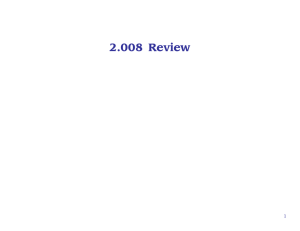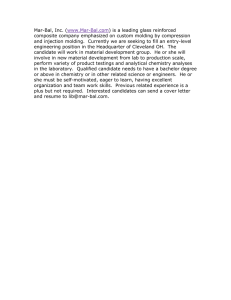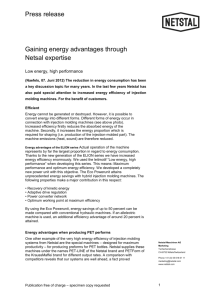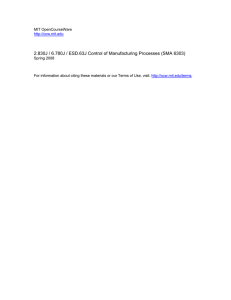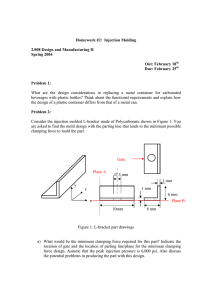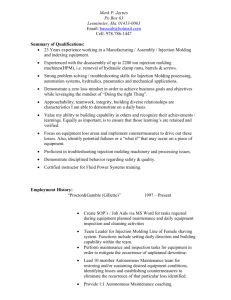the Automotive Brochure
advertisement
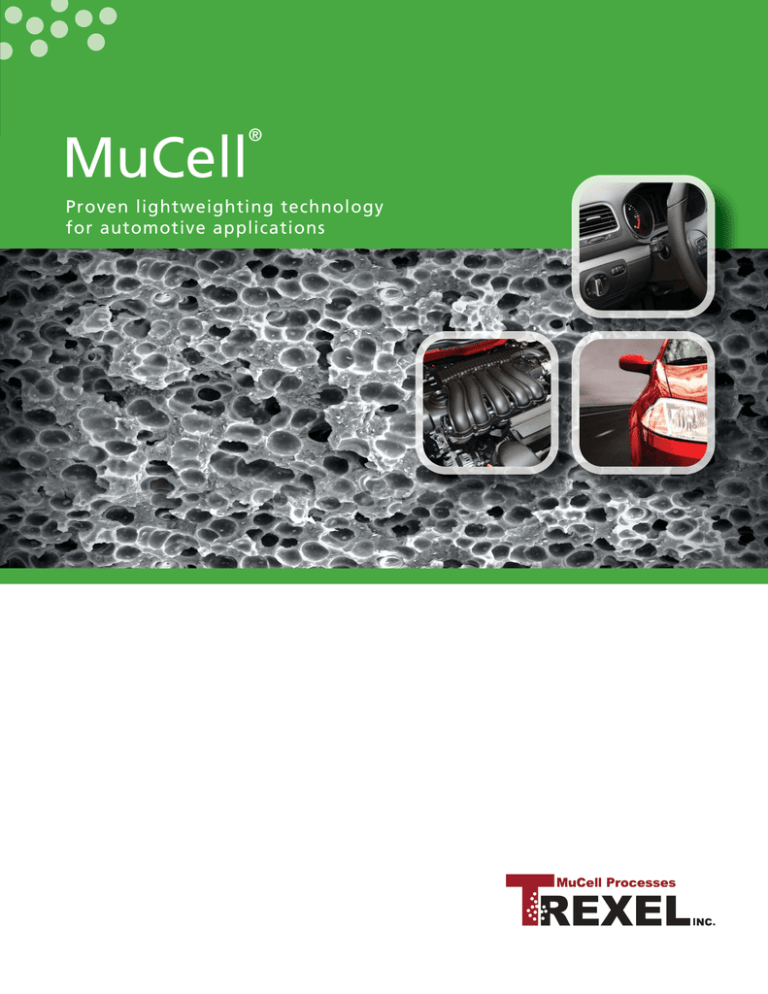
® MuCell Proven lightweighting technology for automotive applications MuCell® Molding Technology The most significant plastic processing innovation in the last 20 years T he MuCell® microcellular foam injection molding process for Unlike chemical foaming agents, the physical MuCell® process thermoplastics materials provides unique design flexibility and has no tempertature limitation and does not leave any chemical cost savings opportunities not found in conventional injection residue in the polymer; making consumer products perfectly molding. The MuCell® process allows for plastic part design with suitable for recycling within the original polymer classification material wall thickness optimized for functionality and not for the and allowing re-grind material to reenter the process flow. injection molding process. The combination of density The numerous cost and processing advantages have led to reduction and design for functionality often results in material rapid global deployment of the MuCell® process in automotive, and weight savings of more than 20%. consumer electronics, medical device, packaging and By replacing the pack & hold phase with cell growth, lower stress consumer goods applications. parts are produced which have enhanced dimensional stability and substantially reduce warpage. Cell growth also results in the elimination of sink marks. Lightweighting Reduced Costs ■ 8-12% material density reduction ■ Reduced resin consumption ■ 20 - 30% total part weight reduction by designing for MuCell ■ Faster molding cycle time ■ Increased yields ■ Smaller molding machine ■ Use of lower cost filled polyolefin material Sustainability Design Freedom ■ Reduced petroleum based material consumption ■ Thin to thick wall flow ■ Reduced molding machine energy consumption ■ 1:1 wall thickness rib structure ■ Ability to re-grind / re-use molded parts ■ Material where needed for function versus flow ■ Reduced carbon footprint versus solid molding ■ Improved dimensional stability ■ Less warpage FOUR TECHNOLOGY STEPS 1 2 4 3 1 2 During plasticization, precisely metered amounts of supercritical fluid (SCF), typically Nitrogen or CO2, are introduced into the polymer through injectors mounted on the plasticizing barrel. Homogeneous mixing and disbursing of the supercritical fluid into the polymer through the specially designed mixing section of the plasticizing barrel, creates a single phase solution of SCF and molten polymer. 3 4 Low pressure filling of mold cavities. Pack & hold phase is replaced by controlled cell growth, which ceases once the mold cavity is filled. Cell growth results in a uniform pack pressure throughout the mold cavity. Injection of polymer into mold cavities. Cells start to nucleate once exposed to lower pressure in the mold cavity. Molecular dispersion of SCF provides for a homogeneous closed cell structure with a solid skin layer. MuCell®/ Polymer Value Match Good Value Great Value HDPE Acrylic HDPE Glass PVC HIPS PVC PP Glass TPE HIPS TPE PPO Blends ABS PA6/6.6 Unfilled ABS PSU TPV GPPS TPV PIE PP Unfilled POM PP Unfilled PA6/6.6 Glass TPO PBT Glass TPO Virtually all polymers will develop a cellular structure with the MuCell® process except for LCP. Filled materials tend to offer the greatest value as fillers act synergistically with the supercritical fluid to provide the best combination of weight reduction and cycle time reduction. Unfilled amorphous materials also foam very well and can provide good weight reductions but with less cycle time benefits than filled materials. High temperature materials such as PEEK, PEI and PSU also provide significant cost reduction based on material price. The MuCell® Application Advantage: The freedom to design for functionality and not for plastic process limitations B y replacing the tradition pack & hold phase of the solid ® Using the same principle, nominal wall thickness can be reduced molding process with cell growth, the MuCell process while using thicker ribs to meet structural requirements. The allows for uniform and locally applied pack pressure through cell cell expansion will eliminate sink marks and the cell structure growth. This allows part design to be optimized with material will prevent the formation of vacuum (shrink) voids. Rib to wall thickness in those areas that require strength and reduced wall thickness ratios of 1:1 can be used with the MuCell® process. thickness in areas that are not structural. Gate locations are then placed in the thin cross sections for optimized filling patterns while allowing the cell growth to provide packing in the thicker cross sections at the end of fill. Differences in Wall Thicknesses Filling from “thin to thick” Recommended injection with MuCell® Injection in solid (with MuCell® still possible) “A part molded with the MuCell® process has a solid skin layer and microcellular foamed core which is a closed cell structure. The cell growth is more effective at packing the part than the solid pack phase which allows for increased rib to nominal wall thickness without sink marks. In most cases, it is possible to produce a sink free part with a rib thickness equal to the nominal wall thickness”. Wall to rib ratio 1:1 possible Conventional Design TYPICAL Solid Molding MuCell® Design CYCLE TIME REDUCTION WITH MUCELL ® Total 30 Seconds 3 sec 4 sec 17 sec Total 22 Seconds MuCell® 1.5 0.5 sec sec 14 sec 6 sec Injection Pack & Hold Cooling Motions MuCell® Molding Technology The complete process solution providing for lighter and more accurate plastic parts at lower production costs Climate Control Bezel | Material: Glass filled ABS • Elimination of sink marks • 1:1 ribs to nominal wall • Machine clamping force reduced from 250 tons to 75 tons • 23% cycle time reduction • 10% weight reduction Airbag Cover | Material: TPO • Uniform shrinkage across different wall thicknesses, enhanced dimensional stability • Elimination of readthrough on the tear seam • Improved living hinge functionality down to temperatures of minus 30˚C • Weight / material savings of 9% Engine Cover | Material: Appearance Grade GF PA6 • 7% weight reduction • Improved flatness • Black sections molded in color Mirror Assembly Case Frame | Material: 50% GF PBT • 10% cycle time reduction (5 seconds) • 10% (84 Gram) weight reduction • Reduction of warpage • Machine clamping force reduced from 650 tons to 420 tons Cam Cover | Material: Glass Filled PA • Machine clamping force reduced from 500 tons to 350 tons • Improved cycle times (allows for simultaneous production and assembly process) • Lighter part and improved flatness • Maintain solid surface apprearance AUTOMOTIVE APPLICATIONS HVAC System | Material: 20% talc filled PP • 9-12% weight reduction • 10-15% cycle time reduction • Flatter parts and better fit • Improved long term reliability and better sealing Front Lamp Housing | Material: PP GF10 T20 • 9% weight reduction • Machine clamping force reduced by 50% • Improved screw boss behaviors by elimination of voids (as compared to conventional molding) • Improved material flow and easier cavity filling Instrument Panel | Material: LGF PP • 8% weight savings • 20% cycle time reduction • Machine clamping force reduced by 42% • Significantly reduced warpage Fan Shroud | Material: PA 66 Glass filled, PP Glass filled • Weight / material reduction of 11% • Cycle time reduction of 30% • Machine clamping force reduced by 50% • 200% improvement in fatigue resistance • Cpk values improved >50% Door Module | Material: Glass filled PP • Expansion molded for increased stiffness • Selective expansion from 2 mm to 3 mm • 40% weight reduction IMPLEMENTING THE MUCELL ® PROCESS The MuCell® capable injection molding machine consists of Nitrogen or CO2 supply, a SCF metering and control system, and a specialized plasticizing unit including positive screw control and a shut off nozzle. Back non-return valve Front non-return valve SCF injector SCF metering system Shut off nozzle The technology can be easily integrated into new (OEM Model) or existing (MMU Model) molding machines: MODULAR MUCELL® UPGRADE (MMU) Field retrofit of existing injection molding machines by qualified Trexel technicians. The upgrade consists of a new, MuCell® capable plasticizing unit, positive screw position control, installation and training. OEM SYSTEM For new injection molding machine applications, the following licensed Trexel OEM partners can provide a turnkey MuCell® injection molding system. About Trexel The exclusive provider of the MuCell® Microcellular Foam Injection Molding Technology As a leader in providing lightweighting solutions to the plastics injection molding industry, Trexel, Inc. has T he MuCell® Microcellular foaming technology was originally conceptualized and invented at the Massachusetts Institute extended its MuCell processing solution to blow of Technology (MIT) and in 1995 Trexel was granted an molded automotive components. exclusive worldwide license for the further development and There are several highly desirable attributes of foamed commercialization of the technology. Today, Trexel is the exclusive versus solid blow molded parts: provider of the MuCell® microcellular foam technology for • Weight savings injection molding and maintains an extensive global patent portfolio. Trexel provides world-class engineering support, • The microcellular material structure improves training and other design and processing services, as well as the thermal insulation and acoustical properties equipment and components integral to the MuCell® process. The MuCell technology, a physical foaming process, also has several advantages over the use of chemical foaming agents: From the global headquarters in Boston, Massachusetts, Trexel operates a state of the art plastics processing development • No chemical reaction at narrow processing window laboratory, supporting plastics processors with the definition • No chemical additive residue in final parts and implementation of leading and differentiating plastic molding technologies. • MuCell foamed parts can be recycled in their original polymer designation; the process does not In support of a global client base, Trexel operates subsidiaries alter the chemistry of the polymer in Europe, Japan and Southeast Asia with competent plastics processing engineering capabilities. Trexel’s worldwide subsidiaries are augmented by a network of competent independent representatives and distributors. HEADQUARTERS SUBSIDIARIES TECHNICAL CENTERS MuCell® blow molded polyethylene air duct with 41% density reduction compared to solid. Trexel, Inc. 100 Research Drive Wilmington, MA 01887 USA Tel.: 781-932-0202 www.Trexel.com E U R O P E • C H I N A • J A PA N • K O R E A • N O R T H A M E R I C A • A U S T R A L I A
